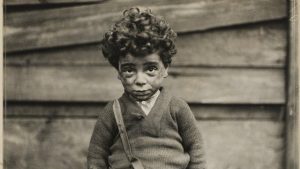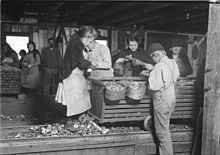10 Chapter 10: Realism ~ The Eyes of Photography, Literature, and Painting
Learning Objectives ~ Chapter 10 “Realism- The Eyes of Photography, Literature, and Painting”
- Define Realism and consider why it became an important lens during the late 19th century and early 20th century
- What is unique about photography? Discuss the medium of photography
- Examine how did Realism manifested in literature and painting by exploring the works of writers and artists
“If I could tell a story in words, I wouldn’t lug around a camera.” ~ Lewis Hine

Lewis Wickes Hine (September 26, 1874 – November 3, 1940) was an American sociologist and photographer. Hine used his camera as a tool for social reform. His photographs were instrumental in changing child labor laws in the United States.
Hine was born in Oshkosh, Wisconsin, on September 26, 1874. After his father was killed in an accident, Hine began working and saved his money for a college education. He studied sociology at the University of Chicago, Columbia and New York University. He became a teacher in New York City at the Ethical Culture School, where he encouraged his students to use photography as an educational medium. Hine led his sociology classes to Ellis Island in New York Harbor, photographing the thousands of immigrants who arrived each day. Between 1904 and 1909, Hine took over 200 plates (photographs) and came to the realization that documentary photography could be employed as a tool for social change and reform.
In 1907, Hine became the staff photographer of the Russell Sage Foundation; he photographed life in the steel-making districts and people of Pittsburgh, Pennsylvania, for the influential sociological study called The Pittsburgh Survey.
Little Lottie, a regular oyster shucker in Alabama Canning Co. (Bayou La Batre, Alabama, 1911)
In 1908 Hine became the photographer for the National Child Labor Committee (NCLC), leaving his teaching position. Over the next decade, Hine documented child labor, with focus on the use of child labor in the Carolina Piedmont, to aid the NCLC’s lobbying efforts to end the practice. In 1913, he documented child laborers among cotton mill workers with a series of Francis Galton‘s composite portraits.
Hine’s work for the NCLC was often dangerous. As a photographer, he was frequently threatened with violence or even death by factory police and foremen. At the time, the immorality of child labor was meant to be hidden from the public. Photography was not only prohibited but also posed a serious threat to the industry.[5] To gain entry to the mills, mines and factories, Hine was forced to assume many guises. At times he was a fire inspector, postcard vendor, bible salesman, or even an industrial photographer making a record of factory machinery. Source
Please watch this lecture on Hine’s work:
https://www.youtube.com/watch?v=uU_4aJpEl34
The lens of the camera saw the world in an objective way, with an undercurrent of narrative that was both provocative and effective. Realism is noted for its objectivism, its portrayal of the human experience devoid of melodrama and sentimentalism. The 19th century in Europe and North America saw the growth of interest in the lives of everyday people. In addition, there grew an interest in issues of gender, class, and social and cultural forces that systemically exploited and degraded people. The arts provided a vehicle for expression and examination of these issues.
************************************
Literary Realism
Literary realism is part of the realist art movement beginning with mid-nineteenth-century French literature (Stendhal), and Russian literature (Alexander Pushkin) and extending to the late nineteenth and early twentieth century. Literary realism attempts to represent familiar things as they are. Realist authors chose to depict everyday and banal activities and experiences, instead of using a romanticized or similarly stylized presentation.
Broadly defined as “the representation of reality”, realism in the arts is the attempt to represent subject matter truthfully, without artificiality and avoiding artistic conventions, as well as implausible, exotic and supernatural elements.
Realism has been prevalent in the arts at many periods, and is in large part a matter of technique and training, and the avoidance of stylization. In the visual arts, illusionistic realism is the accurate depiction of lifeforms, perspective, and the details of light and colour. Realist works of art may emphasize the ugly or sordid, such as works of social realism, regionalism, or kitchen sink realism.
Please read the following selections from “Chapter Two: Realism” in this online textbook here.
Read:
2.2 Introduction
2.2.1 Local Color
2.2.2 Regionalism
2.3 Mark Twain and selections
2.8 Kate Chopin and selections
2.10 Charles Waddell Chestnutt and selections
Learning Outcomes
After completing these selections in this chapter, you should be able to:
• Describe the post-Civil War context of American culture at the time Realistic writing came into prominence.
• List the features of American Literary Realism.
• List the features of the two sub-movements that preceded Realism: Local Color and Regionalism.
• Identify stylistic elements of Local Color, Regionalism, and Realism in literary selections.
• Identify major distinctions and differences among the literary styles of Local Color, Regionalism, and Realism.
• Analyze the ways in which women’s literature develops in this period.
• Analyze themes in an early work by an African-American writer.
************************************
Realism in Painting
Another major French artist often associated with the realist tradition, Honoré Daumier, drew satirical caricatures of French society and politics. He found his working-class heroes and heroines and his villainous lawyers and politicians in the slums and streets of Paris. Like Courbet, he was an ardent democrat, and he used his skill as a caricaturist directly in the service of political aims. Daumier used energetic linear style, boldly accentuated realistic detail, and an almost sculptural treatment of form to criticize the immorality and ugliness he saw in French society.
Pictorial realism outside of France was perhaps best represented in the 19th century in the United States. There, Winslow Homer’s powerful and expressive paintings of marine subjects and Thomas Eakins’s portraits, boating scenes, and other works are frank, unsentimental, and acutely observed records of contemporary life.
Realism was a distinct current in 20th-century art and usually stemmed either from artists’ desire to present more honest, searching, and unidealized views of everyday life or from their attempts to use art as a vehicle for social and political criticism. The rough, sketchy, almost journalistic scenes of seamy urban life by the group of American painters known as The Eight fall into the former category. The German art movement known as the Neue Sachlichkeit (New Objectivity), on the other hand, worked in a realist style to express the cynicism and disillusionment of the post-World War I period in Germany. The Depression-era movement known as Social Realism adopted a similarly harsh and direct realism in its depictions of the injustices and evils of American society during that period.
Socialist Realism, which was the officially sponsored Marxist aesthetic in the Soviet Union from the early 1930s until that country’s dissolution in 1991, actually had little to do with realism, though it purported to be a faithful and objective mirror of life. Its “truthfulness” was required to serve the ideology and the propagandistic needs of the state. Socialist Realism generally used techniques of naturalistic idealization to create portraits of dauntless workers and engineers who were strikingly alike in both their heroic positivism and their lack of lifelike credibility.
Here is a succinct lecture that goes over the stylistic elements of Realism:




